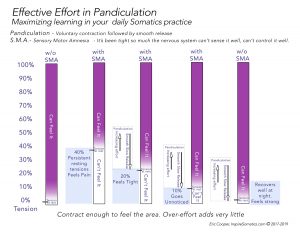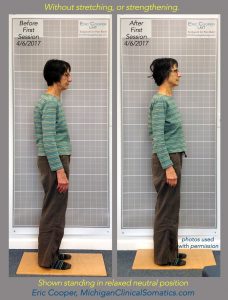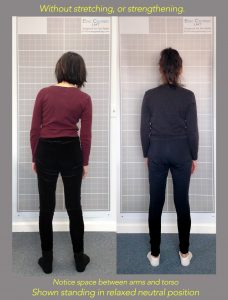Explanation for medical professionals
Eric Cooper guides people through gentle, slow movements that when done with focussed attention, create feedback the sensory-motor system needs to recalibrate the alpha-gamma motorneuron co-activation loop. The result is lowered tonus, resting tension.
This is done with slow intentional movements called: pandiculations and practitioner-assisted pandiculations. The movement patterns activate the musculature in the somatic (SNS) stress reflex contraction patterns (how we react to stress). It also addresses habituated injury reaction tension patterns that quickly become habituated.

This process allows a client to regain control of involuntarily high tonus. The process restores voluntary control of the musculature. The modality is based on anatomy and up-to-date neurophysiology.
His website is inspiresomatics.com
eric@inspiresomatics.com
He would welcome any questions.
Client are able to regain control of tensions that cause spinal compression, tensions that cause stenosis of the vertebral foramina. and disc disease. His work also helps people free themselves from the persistent stress-reaction tensions that cause thoracic hyper-kyphosis. Functional scoliosis responds very well to this practice. This is an ideal way to manage the tensions of more severe cases of scoliosis. This is very effective in freeing a frozen shoulder.

This process was developed by the late Thomas Hanna PhD. He referred to it as a “new field in health care”.
“The object of this exploration is to loosen your body from constricted muscles. It is neuromuscular re-education. Done correctly, these exercises restore sensory motor awareness and control to the brain and muscular system.”-Thomas Hanna, developer of Somatics
*Clarification of the word reflex. I am using the word reflex to refer to somatic reflexes. Somatic reflexes are part of the somatic nervous system, the SNS. This system controls parts of the body that the nervous system can contract voluntarily and involuntarily. How you flinch when you’re startled is a somatic reflex pattern. those muscles can be in our control, or they can seem very automatic. Somatic reflexes are a different type of reflex than the hard wired stretch reflexes the doctor checks with a mallet below your knee.

